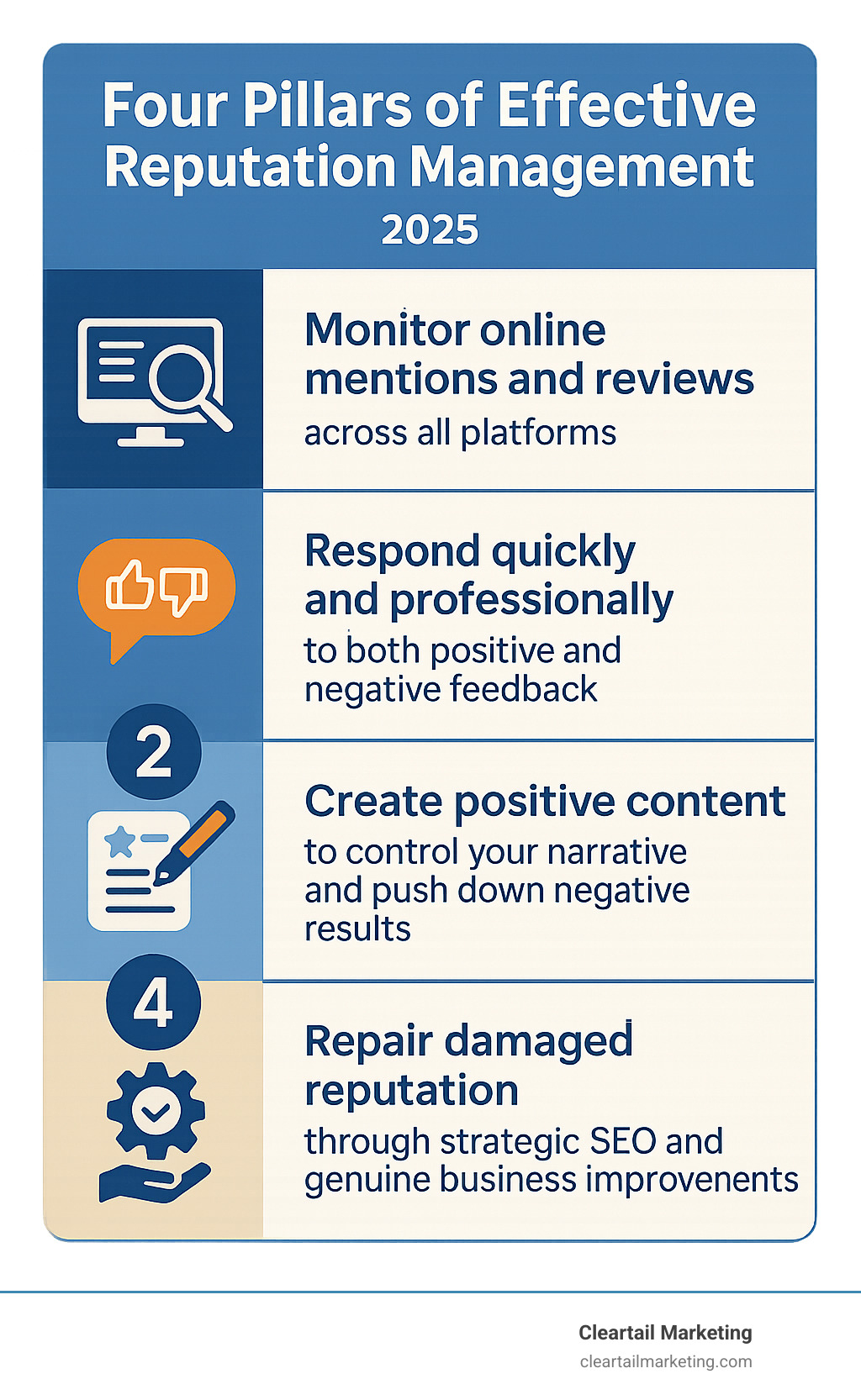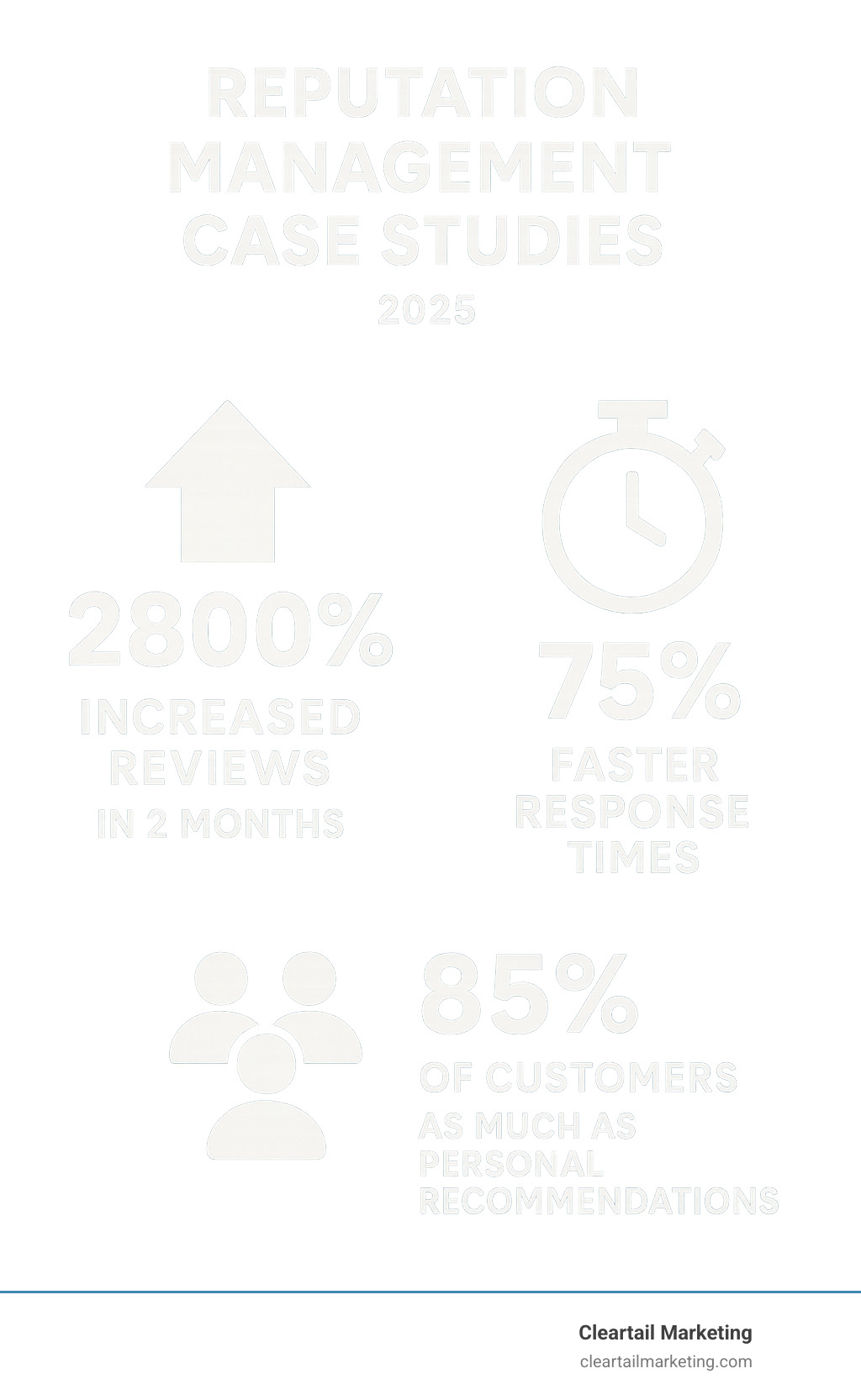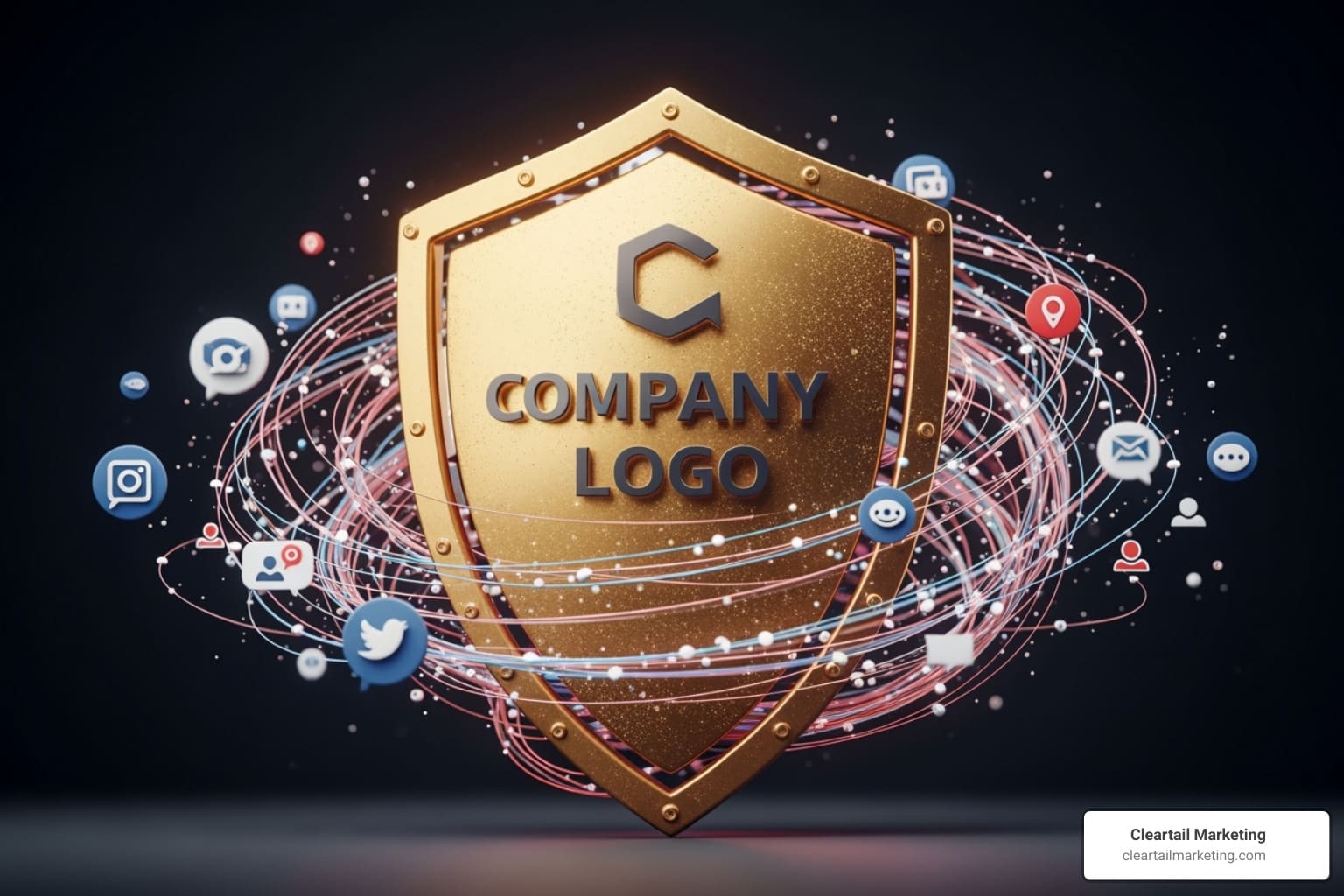Why Reputation Management Case Studies Matter for Your Business
Reputation management case studies reveal the real-world impact of online reputation on business success. These documented examples show how companies steer crises, rebuild trust, and protect their digital presence.
Key Lessons from Top Reputation Management Case Studies:
- Swift Action Saves Brands – Companies like Johnson & Johnson recovered from major crises through immediate, transparent responses
- SEO Controls Your Narrative – Strategic content creation can push negative results to page two within 6-21 months
- Genuine Change Beats Empty Apologies – Domino’s Pizza turned criticism into a complete brand change
- Poor Crisis Response Amplifies Damage – United Airlines’ defensive stance made a bad situation exponentially worse
- Proactive Review Management Works – Some companies increased reviews by 2,800% in just two months
With visitors forming a first impression in under 0.2 seconds, and four negative search results costing you 70% of potential business, learning from proven strategies is critical. The most successful case studies share common elements: speed, transparency, and genuine accountability. From Starbucks closing 8,000 stores for training to an executive clearing their name on Google, these examples provide a roadmap for protecting your reputation.
I’m Magee Clegg, founder of Cleartail Marketing. Since 2014, we’ve helped over 90 B2B companies grow by implementing the same proven strategies found in these case studies, generating results like a 278% revenue increase for one client in just 12 months.

Reputation management case studies terms to remember:
Lesson 1: Swift, Transparent Action is Non-Negotiable

When studying reputation management case studies, one truth emerges: companies that survive major crises act fast and tell the truth. It’s not about PR spin, but about owning the problem and putting customers first.
Successful crisis responses have three core elements: swift action, complete transparency, and genuine empathy. Leaders who show real accountability, not excuses, earn customer loyalty.
The Tylenol Gold Standard
The 1982 Tylenol crisis created the modern crisis management playbook. After seven deaths from cyanide-laced capsules, Johnson & Johnson faced a potential death sentence for its most profitable product.
Instead of playing defense, they went on the offensive for customer safety. They immediately recalled 31 million bottles nationwide, a decision worth approximately $100 million.
Their genius was complete transparency. Instead of hiding or blaming, they put customer safety first, even though the tampering happened post-production. The company worked openly with law enforcement and the media, keeping the public informed.
The innovation that followed showed their commitment was genuine. They introduced tamper-resistant packaging that became the industry standard, aiming to prevent future crises.
Today, the Tylenol brand is stronger than ever. This case study proves that when you prioritize customer safety and transparency, customers reward you with loyalty.
The Starbucks Response
In 2018, Starbucks faced its own crisis when two African-American men were arrested in a Philadelphia store. The incident went viral, sparking outrage and requiring an immediate response.
CEO Kevin Johnson didn’t hide behind corporate speak. He issued a swift, personal apology and took full responsibility. But Starbucks backed up its apology with unprecedented action.
They closed more than 8,000 stores across the United States for an afternoon of racial bias education for 175,000 employees. The financial cost was enormous, but the message was clear: some things matter more than short-term profits.
The company’s commitment to change was ongoing. They implemented new policies, continued education, and opened their restrooms to everyone, not just customers. This was genuine change, not just damage control.
More about Starbucks’ company values shows how this response aligned with their mission. By demonstrating accountability through actions, they turned a potential disaster into an opportunity to strengthen their brand.
Both companies understood that taking responsibility is about showing leadership when customers need it most. That’s the difference between crisis management and reputation management.
Lesson 2: Own Your Search Results with Proactive SEO

What appears when someone searches your name? Successful reputation management case studies prove you can control your search results. With strategic SEO, you can push down negative content and replace it with positive, accurate information.
Think of search results as prime real estate. The first page of Google is the most valuable. You want to control what people see. This is where Business Reputation Crisis Management becomes your secret weapon.
Pushing Down Negative Press
Consider a financial executive’s nightmare: a major news agency published a false, damaging report about him. The article threatened his career and personal life daily.
Every time someone searched his name, that negative article was at the top of Google. Job opportunities vanished and business relationships suffered.
Strategic SEO turned the tide. By creating high-quality positive content on reputable sites and using proven technical SEO, his team generated authentic content that told his real story.
The results speak for themselves. Within 12 months, the damaging article was pushed to the bottom of page one. By month 14, the first page was completely cleared of negative content. The executive got his life back, and his reputation was restored.
Protecting Individuals and Philanthropists
The challenge can be greater. A respected philanthropist became the target of a viral controversy, with hard-to-displace negative video content.
The approach was comprehensive and patient. The team focused on PII removal, successfully eliminating 97% of exposed personally identifiable information within eight weeks.
They created over 50 positive profiles across various platforms, each telling a part of the philanthropist’s real story. By building white-hat backlinks, they boosted positive content rankings and established genuine authority.
The change was remarkable. Within six months, six positive links claimed spots on the first page, and two strong negative links were pushed off entirely. By the 21-month mark, anyone searching this person’s name would find only positive, accurate information.
This case proves that even with severe reputation challenges, recovery is possible with the right strategy and persistence.
Lesson 3: Accept Criticism as a Catalyst for Genuine Change

Many companies treat criticism like poison, but it’s medicine. The best reputation management case studies show that businesses using negative feedback to drive real change emerge stronger.
It takes courage to admit you’re wrong and even more to fix the problem publicly. When companies do this right, they don’t just recover—they transform.
The Domino’s Pizza Turnaround
In the late 2000s, Domino’s Pizza faced a brutal truth: customers disliked their pizza. Instead of defensive PR, they did something radical: they agreed with their critics.
Their “Facing the Music” campaign was unprecedented. Domino’s publicly acknowledged their pizza wasn’t good enough and committed to starting over. They revamped their entire core pizza recipe based on customer feedback.
Domino’s documented the change openly, showing how they addressed complaints. They invested in technology to improve the customer experience and continued listening and improving long after the campaign.
This Brand Perception Case Study shows how powerful genuine change can be. Domino’s went from being mocked for poor quality to being recognized as an innovation leader, with stock prices and sales reflecting the shift.
The lesson? Sometimes the best response to criticism isn’t a better explanation—it’s a better product.
Volkswagen’s Post-Scandal Pivot
The Volkswagen “Dieselgate” scandal of 2015 is a complex example of learning from failure. When regulators found that 11 million cars worldwide contained devices to hide harmful emissions, Volkswagen faced a crisis that threatened its survival.
Their initial response was a lesson in what not to do. A scripted apology, minimizing the problem’s scope, and stalling instead of acting only made the situation worse.
But Volkswagen eventually shifted to a long-term strategy focused on genuine change. They committed $20 billion to electric and hybrid vehicle development by 2023. More importantly, they completely pivoted their production strategy toward electric motors, rebuilding their business model.
This change took time and enormous investment, but Volkswagen returned to its position as the world’s #1 car manufacturer by 2018. The company proved that even severely damaged reputations can recover when backed by a sustained commitment to real change.
Lesson 4: Understand the High Cost of a Mishandled Crisis

Sometimes the most valuable reputation management case studies are the ones that went horribly wrong. These failures teach us what happens when companies choose defensiveness over accountability and underestimate public sentiment.
A crisis doesn’t have to destroy your brand, but a terrible response to that crisis can. Let’s examine two companies that learned this the hard way.
The United Airlines PR Disaster
In April 2017, United Airlines turned a manageable situation into a reputation disaster. The issue began with an overbooked flight.
When security forcibly dragged Dr. David Dao off the plane, passengers filmed the incident, and videos went viral. At this point, United had a serious, but not yet catastrophic, problem.
What followed was a global nightmare. The CEO defended the airline’s actions, calling the incident a “re-accommodation” and blaming the passenger. This stunning lack of empathy showed more concern for procedure than the human cost.
It took days of mounting pressure before United issued a genuine apology. By then, the damage was done. The company’s stock price dropped, and United became a global symbol of poor customer service.
This case perfectly illustrates Why Online Reputation Management is Important—the cost of getting crisis response wrong far exceeds any investment in getting it right. United’s defensive approach amplified the damage exponentially.
Gillette’s Controversial Ad
Gillette’s 2019 “The Best Men Can Be” ad presents a different challenge: how well-intentioned messages can backfire when they alienate your core customer base.
The ad addressed toxic masculinity, aiming to position Gillette as a progressive brand. Instead, it triggered a massive backlash from longtime customers.
The numbers tell the story: the YouTube video received 1.6 million dislikes versus 800,000 likes. Customers felt lectured by a razor company, interpreting the ad as an attack on men as a group.
Unlike United, Gillette stood by their message, refusing to apologize and committing to donations. While some praised this stance, the divisive brand activism came at a significant cost to P&G’s bottom line.
This case study teaches that taking controversial positions requires careful consideration of your audience. Sometimes being right isn’t enough if it means losing customer trust.
Both United and Gillette learned that poor communication and tone-deaf responses can escalate crises faster than ever before.
Lesson 5: Systematically Generate and Manage Positive Reviews

While crisis management gets headlines, the most practical reputation management case studies focus on what every business controls: reviews. Systematic review management creates measurable improvements that impact your bottom line.
Think of reviews as digital word-of-mouth. When managed properly, they build trust and attract customers. The best companies don’t just hope for good reviews—they create systems to generate them.
Explosive Growth in Reviews
The Concourse Sports case study shows what happens when you treat review generation as a business process. This company increased reviews by 2,800% in just two months.
They understood that satisfied customers will help if asked correctly. The team implemented systematic follow-up processes to reach customers when their positive experience was fresh.
They made the process effortless with direct links to review platforms and clear instructions. Staff training ensured everyone understood why reviews mattered for business growth.
This approach works across industries. Our Reputation Management for Contractors has helped similar businesses achieve comparable results by implementing these same systematic processes.

Improving Ratings and Response Time
Getting more reviews is only part of the equation. The quality of those reviews and your response speed are critical.
Ashley Furniture increased their average review rating by 14% by focusing on service quality improvements and proactive communication. Instead of waiting for online complaints, they reached out first to ensure satisfaction.
They understood that a negative review is a missed opportunity to solve a problem privately. Through professional response training and systematic follow-ups, they turned potential complaints into positive experiences.
Meanwhile, Hwy 55 Burgers, Shakes, and Fries achieved 75% faster review response times by treating review monitoring as seriously as food safety. Research has shown that high-quality service and transparent communication significantly influence consumer perception.
Their system included real-time monitoring alerts, professional response templates, and clear escalation procedures. As a result, customers felt heard and valued, even when their initial experience wasn’t perfect.
These reputation management case studies prove that review management isn’t about manipulation. It’s about creating systems that deliver better customer experiences and communicate your commitment to satisfaction.
Frequently Asked Questions about Reputation Management Case Studies
What can we learn from successful reputation management case studies?
Successful reputation management case studies teach predictable principles that any business can apply.
- Speed is critical: Responding within hours, not days, can cut recovery time in half.
- Transparency builds trust: Acknowledge problems fully and take responsibility from day one.
- Actions speak louder than words: Customers forgive when they see a real commitment to change, like Domino’s recipe overhaul.
- SEO gives you control: Strategic content can push negative results down in search rankings within 6-21 months.
- Systems deliver results: Systematic approaches to review management and crisis response create lasting, measurable outcomes.
For more examples, explore Our Case Studies to see these principles in action.
What are common mistakes seen in failed reputation management case studies?
Failed reputation management case studies are often preventable, with the same mistakes appearing repeatedly.
- Slow response times: Waiting allows negative narratives to solidify.
- Defensive attitudes: Blaming others destroys goodwill.
- Hiding information: Minimizing problems or withholding facts ruins credibility.
- Generic apologies: Insincere corporate-speak often creates more anger.
- Ignoring root causes: Failing to fix the underlying issue guarantees repeat problems.
- Underestimating social media: Not grasping the speed of viral content leads to being overwhelmed.
- Inconsistent messaging: Conflicting statements signal a lack of control.
How long does it take to see results from a reputation management campaign?
The timeline for reputation management case studies varies, but here are realistic expectations:
- Severity: Minor issues (negative reviews) can be balanced in 2-6 months. Major crises (viral incidents, legal issues) can take 12-24 months to resolve.
- Content Type: Balancing reviews takes 2-6 months. Pushing down negative news articles with SEO takes 6-14 months.
- Investment & Effort: Comprehensive, sustained strategies yield faster results than sporadic efforts. Consistency is key.
- Starting Point: A pre-existing positive digital footprint accelerates recovery.
Generally, expect initial improvements in 2-6 months, significant progress in 6-12 months, and complete resolution for major projects in 12-24 months.
For specific timelines and investment levels, consider reviewing Online Reputation Management Cost to understand what different approaches require.
Conclusion

Powerful reputation management case studies make one thing clear: reputation isn’t just damage control. It’s about building a resilient brand.
Speed and transparency are survival tools. Companies that respond within hours and tell the complete truth consistently come out ahead. This pattern repeats across industries and decades.
Controlling your narrative through SEO can rewrite your story. As case studies show, strategic content can clear negative results from Google’s first page in 6-21 months. This is methodical, professional work.
The companies that truly win are those that use criticism as fuel for genuine change. Domino’s didn’t just apologize for bad pizza—they rebuilt their recipe. Volkswagen didn’t just say sorry—they invested $20 billion in electric vehicles.
On the flip side, defensive responses turn problems into disasters. United Airlines’ handling of the passenger removal incident shows how quickly things spiral when a company won’t take responsibility.
And systematic review management has immense power. When one company increased their reviews by 2,800% in two months, it was a deliberate, well-executed strategy.
Proactive reputation management is the difference between thriving and surviving. Investing in monitoring, response protocols, and positive content creation before a crisis provides a crucial advantage.
At Cleartail Marketing, we’ve helped businesses implement these exact strategies, translating the lessons from these reputation management case studies into real-world results.
Your reputation precedes you, influencing customers, partners, and potential employees. It’s largely shaped by what people find when they search for you online.
Learning from real-world examples is the first step to building a better defense for your own brand. For a comprehensive strategy custom to your needs, explore our Reputation Management Services and find how we can help you implement these proven strategies for your business.
Remember: your reputation is too valuable to leave to chance. Make sure it’s telling the story you want told.



